Why Can't I Find Settings Reading on Wordpress Dashboard
Feb ten, 2022
Will M.
8min Read
How to Fix 404 Error on WordPress Posts and Pages (iii Methods)
The WordPress 404 error is one of the well-nigh common bugs you'll run across online. Yet, that doesn't brand it any less abrasive or harmful when information technology appears on your own website. The expert news is that fixing it is relatively elementary, and the process is well-documented for WordPress websites.
Download WordPress Cheat Sheet
In this article, we're going to walk you through three ways you tin tackle the WordPress 404 error:
- Resetting your WordPress permalinks.
- Restoring your.htaccessfile.
- Disabling your themes and plugins.
Before we roll up our sleeves, though, we're going to take a moment to talk almost how error 404 works and what its mutual causes are. Let's get right to it!
| Error code | HTTP Fault 404 |
| Fault blazon | Client-side |
| Error variations | Fault 404 404 Not Found Folio Not Institute Not Found The page cannot be establish The requested URL was not institute on this server. Nosotros tin can't find the page yous're looking for. The requested URL was not establish on this server. That'south all we know. |
| Error causes | Wrong URL Caching problems Problem with DNS settings WordPress compatibility problems |
Video Tutorial
Too busy to read? Check out our video tutorial.

Subscribe For more educational videos! Hostinger Academy
What Is WordPress 404 Error And What Causes Information technology?
Error 404 pops up when y'all try to access a folio and your browser tin't find it. Depending on which browser y'all utilize, the bulletin can vary slightly in its presentation. Firefox, for example, hits you with a "404 Not Found" error. Chrome, on the other hand, shows you a message that reads "404. That'south an error.":
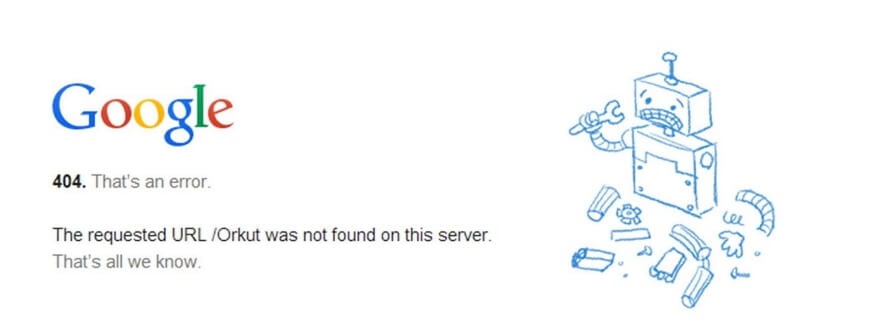
While these default error messages tin can be quite vague, any website can set up its own custom 404 error page. This isn't strictly necessary, but it enables them to explicate to visitors that the site does work, and the simply problem is the specific page they're trying to look up.
Regardless of what they look like, at that place are a lot of things that can cause a WordPress 404 mistake to occur. These include:
- A mistyped URL. In some cases, the mistake tin can be as simple as an actress letter typed in the page's URL.
- Caching problems. Sometimes, your browser may enshroud the page you're trying to access while it tin't be found, so y'all'll keep seeing mistake 404 even if your site is working for everyone else.
- An result with your Domain Name Server (DNS) settings. Your domain may not have propagated yet to the DNS you're using, so yous see the fault when you lot endeavor to access one of your site'due south pages.
- WordPress compatibility problems. In some cases, issues with a plugin or theme may affect the way WordPress generates URLs and permalinks for your website. Then, if anyone tries to access an URL that doesn't work anymore, a WordPress permalinks 404 error occurs.
It'south important to understand that the 404 error isn't unique to WordPress alone. It tin can crop upwards regardless of which platform your website uses. Yet, if you lot're using WordPress, you have an advantage – at that place are plenty of means y'all can go about troubleshooting the issue. Let'due south talk about what to practise if you detect yourself faced with a WordPress error 404.
What to Do Earlier Troubleshooting the WordPress 404 Error
In the side by side few sections, you'll be editing some files on the WordPress backend. We'll guide you through the unabridged process, so nothing is likely to go incorrect. Still, whenever you're about to edit sensitive files in WordPress, it makes sense to back up your website beforehand – just in instance.
It's easy to do it using a plugin like All-in-1 Migration, simply if yous don't have access to your WordPress dashboard right now, don't worry. On Hostinger, you can fill-in of your website direct from the hosting control console.
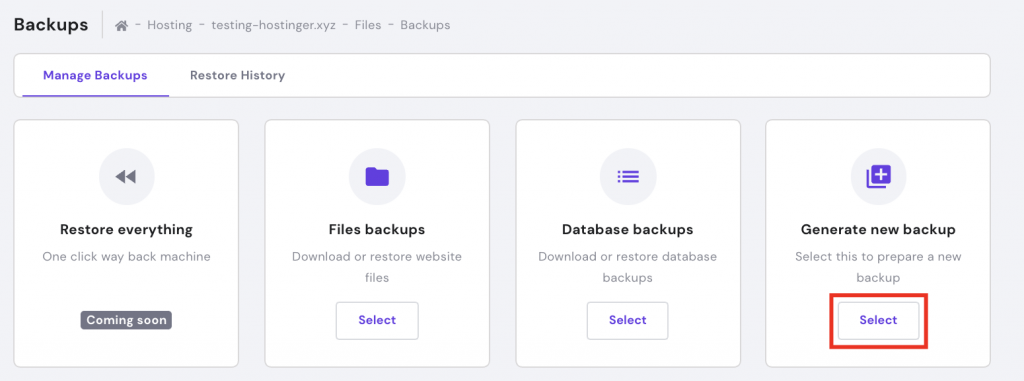
Subsequently that, you lot'll want to download and gear up up a File Transfer Protocol (FTP) customer. Nosotros recommend FileZilla, which is open-source and offers all the features you might need. If you've never used FTP before, you can check out our full guide on how to access your Hostinger website straight. Then, when yous're ready, y'all can get to work on fixing those WordPress 404 pages.
How to Set the WordPress 404 Error (3 Methods)
In some cases, WordPress page not constitute errors shortly disappear on their ain. This typically happens if they are caused by an error with your web hosting provider. Before starting any serious troubleshooting, we recommend that you endeavor strength-refreshing your website, after giving it v or ten minutes to sort itself out.
If error 404 persists for longer than that, it'southward safe to assume that there's an underlying issue with your website. In that case, let'southward run through three potential solutions, one by one.
1. Reset Your WordPress Permalinks
One of the most common causes of the WordPress 404 error is a trouble with the way WordPress generates your permalinks. As yous may know, WordPress provides you with several options for formatting your posts and pages' links. For example, you tin can configure the platform to use apparently numeric links, or set each post'due south name as its URL. If the links are misconfigured, they might be not plant and throw a 404 error
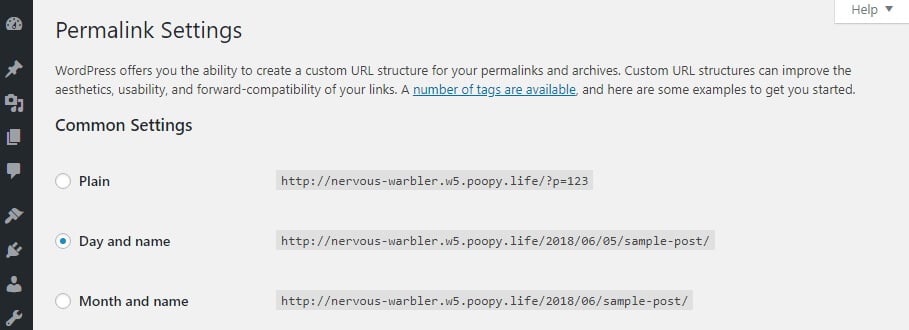
In whatsoever case, the first thing you'll want to practice when you run into a 404 error on a WordPress post is to reset your permalinks. There are two means to do this, one through your dashboard and another via FTP. If you have access to your dashboard, you lot'll want to follow the residual of the instructions in this department. Otherwise, you should skip down to method number ii.
If you can get into your dashboard, start by navigating to yourSettings › Permalinkstab. Once y'all're in, you'll desire to take annotation of which structure your site is using at the moment. Y'all'll need to change it temporarily in gild to reset WordPress' permalink settings, merely you lot'll change information technology back in a moment.
For now, select thePlainoption underCommon Settings, and click on theSavepush button at the bottom of the page:

The page will reload. Then you can go ahead and choose your previous permalinks type, and save your changes again. That's all it takes to reset your WordPress permalink structure.
Now, become alee and endeavor to browse your website every bit yous would normally. Check out the pages that returned WordPress 404 errors before, and run across if they persist. If the error is gone, and then pat yourself on the back – it simply took you one shot to fix it!
ii. Restore Your WordPress.htaccessFile
When you brand changes to your WordPress permalink construction, they go saved to a file called.htaccess. That particular file governs how WordPress interacts with its server, as well as the way it generates URLs for your pages.
If you don't have access to your dashboard due to the WordPress posts 404 error, you'll need to edit.htaccessmanually to reset your permalinks. To go started, access your website via FTP and navigate to your WordPressrootfolder. This is the directory that contains your WordPress installation, and it's commonly located in a folder calledpublic_html orwww,or is named after your website:

Open that binder now, and look for the.htaccessfile within. If you're using FileZilla, you'll desire to right-click on the.htaccessfile and select the option that saysView/Edit. What this does is download a copy of the file to your computer, and open up it using your local default text editor. Now, yous'll exist able to make any changes you want to information technology.
If y'all don't sympathise what all the code in this file does, don't worry. You shouldn't brand any changes to it unless you lot're sure nearly them anyway. Notwithstanding, what you lot tin can practise is utilise the default WordPress.htaccesscode, which looks like this:
# BEGIN WordPress <IfModule mod_rewrite.c> RewriteEngine On RewriteBase / RewriteRule ^index\.php$ - [L] RewriteCond %{REQUEST_FILENAME} !-f RewriteCond %{REQUEST_FILENAME} !-d RewriteRule . /index.php [L] </IfModule> # END WordPress That's a bare.htaccessfile, with no modifications to it. That means information technology will remove any changes made to your permalink structure. Go ahead and backup the contents of your old.htaccessfile at present, and supervene upon them with the code snippet above.
Subsequently that, relieve the changes to your.htaccessfile using your text editor and shut it. FileZilla will ask if you want to supervene upon your existing.htaccessfile with the re-create you just edited. Concur to the prompt, and that'southward it! You only reset your WordPress permalinks manually, without breaking anything in the process.
At this bespeak, become alee and endeavor to admission WordPress once more. The 404 error should exist gone, which is excellent news. Still, you'll notwithstanding desire to put your permalink structure dorsum to the way it was before unless you like numeric URLs for your posts.
Recall, yous tin change the way your permalinks await by going into your dashboard and navigating to theSettings › Permalinkstab. Once you're in, merely cull the structure your website used before the whole 404 debacles started, and save your changes. Then, everything should be back to normal.
three. Disable Your WordPress Themes and Plugins
As we mentioned earlier, sometimes your plugins and themes can affect your WordPress URL construction, depending on their settings. If yous tried i or both of the previous methods and the WordPress 404: folio not plant fault nonetheless persists, disabling your themes and plugins is your best bet.
There are 2 ways to do this, depending on whether y'all take admission to your dashboard or not. If yous practice take access, go to thePlugins › All Pluginstab and follow this process for each of your plugins:
- Click on theDeactivatebutton below the plugin'southward name.
- Check your site, to run across if the 404 fault persists.
- If the mistake is nonetheless there, re-activate the plugin yous disabled.
- Move to the side by side plugin on the listing, and repeat the process.
Your goal here is to eliminate each plugin as a suspect, one by one. You could disable all of them at one time, but in virtually cases, it'south a single plugin that'southward causing your problems. If disabling one of your plugins fixes the event, you lot have three options. You tin can see if there's an update available, keep the plugin temporarily disabled until at that place'south an update, or uninstall it and expect for an culling.
If yous've checked all your plugins and none of them is to blame, you'll besides want to make certain your active theme isn't behind the 404 error. This process is much faster since you lot just have to check 1 theme. Go to yourThemestab and switch your active theme to anything else:
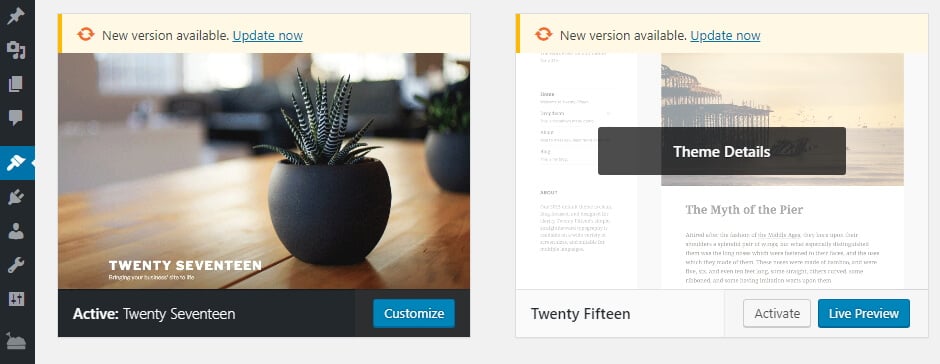
Now, check to see if the WordPress 404 mistake is gone. If it is, and then you again have to choose between looking for an update or finding a new theme. Switching WordPress themes tin exist a bit of a hassle, but it's worth it in the long run if your electric current theme is resulting in errors.
If you don't have access to your dashboard, you can nonetheless disable your theme and plugins manually via FTP. To do this, admission your website using FileZilla, then navigate to thepublic_html/wp-contentdirectory. You'll observe several folders here, 2 of which are chosenpluginsandthemes respectively:

Go into thepluginsdirectory first. You'll observe that there are individual folders for each plugin installed on your website. What you want to do is select ane of those folders, right-click on it, and choose theRenameoption:

Change the folder'due south name to something likeakismet.disabled, so y'all can nonetheless easily place it. The mere act of changing the plugin folder'due south proper name is enough for WordPress to disable it. At present, check to come across if the folio not found mistake is gone. If it isn't, render that binder to its original name, and repeat this process in turn for each other plugin within the directory.
If ane of your plugins is behind the error, yous know how to deal with it by at present. Even so, if they all come up clean, you lot tin can move on to thewp-content › themesdirectory. Once you're in, look for your active theme'southward folder and rename information technology, just equally you did with your plugins:
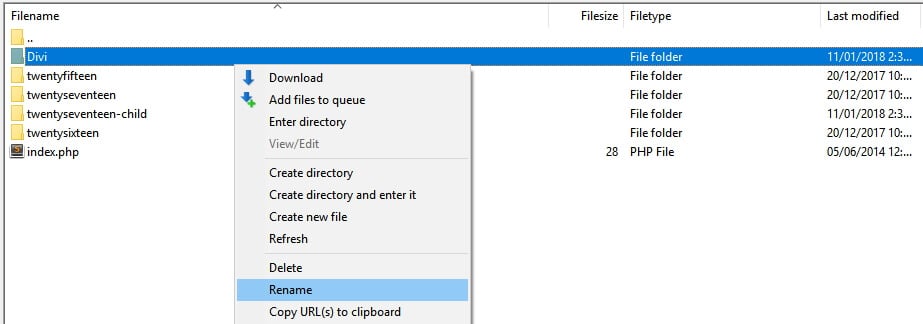
Since WordPress always needs an active theme, disabling yours will cause the platform to default to 1 of its out-of-the-box options. This can affect the way your website looks, merely don't worry, information technology's only temporary.
If the fault is gone, you may need to look for a new theme. Notwithstanding, if it isn't, feel costless to restore your theme'southward folder to its original name, so WordPress recognizes it again.
Further Reading
404 error is non the only issue that WordPress websites may see. Here's a listing of the most popular WordPress error with in-depth coverage on how to handle them:
- How to Ready 403 Forbidden Mistake in WordPress
- How to Fix 500 Internal Server Error in WordPress
- How to Fix 502 Bad Gateway Error in WordPress
- How to Set up 503 Service Unavailable Error in WordPress
- How to Fix 504 Gateway Timeout Error in WordPress
- How to Fix "the uploaded file exceeds the upload_max_filesize directive in php.ini." error
- How to Fix the "Lamentable, You lot Are Not Allowed to Access This Page" Error in WordPress
Conclusion
The WordPress 404 error may seem elementary, merely it tin can do a lot of damage. If your visitors can't observe the pages they want, they might look elsewhere for what they need. That translates to lost traffic, and potentially fewer conversions.
Fortunately, there are plenty of ways yous can fix this trouble in WordPress, including disabling your themes and plugins, restoring your.htaccessfile, and resetting your permalinks.
Do you take any questions, tips, or tricks on how to approach the WordPress 404 error? Let'south talk about them in the comments department below!
Source: https://www.hostinger.com/tutorials/fix-404-error-wordpress
0 Response to "Why Can't I Find Settings Reading on Wordpress Dashboard"
Post a Comment